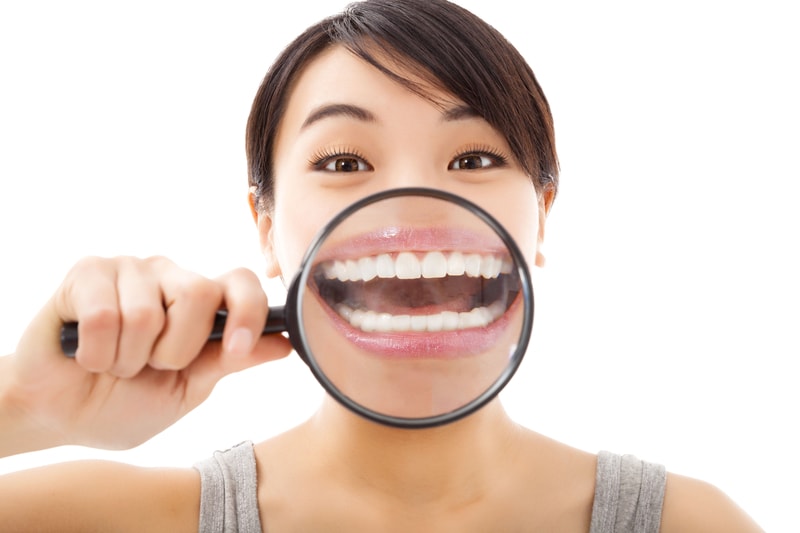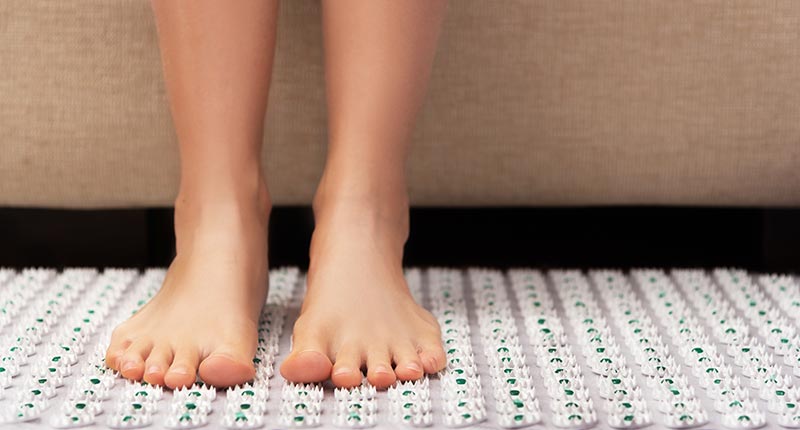I had to have my wisdom teeth removed, but the pain I had to deal with until the oral surgery could be scheduled was unbearable. It hurt to eat and even speak. I wish I had known about using acupressure for a toothache back then so that I could have relieved the pain until my appointment. Although it cannot treat the underlying causes, these acupressure points for tooth pain can quickly and easily be used to bring relief from toothaches. It’s still important to seek medical treatment and practice good oral hygiene.
Sleeping with a toothache can be uncomfortable, to say the least. Sometimes, you may not be able to sleep at all. However, there are many acupressure points for tooth pain that aid in relieving the tooth pain directly, as well as helping you to fall asleep. According to WebMD, tooth pain is caused by the irritation of the nerve in the root of the tooth or surrounding teeth. Infection, decay, injury, and loss of a tooth are the most common reasons for tooth pain. However, pain may also occur after having a tooth removed. Pain can also originate in the jaw, ears, sinuses, and occasionally even heart problems, thereby mimicking tooth pain. Tooth pain can be prevented by flossing, brushing with fluoride toothpaste, and having your teeth cleaned professionally by a dentist twice per year.
The World Health Organization (WHO) noted using acupressure points for tooth pain as effective for dental pain in 2003. It is believed to work by changing how the brain perceives and processes pain signals from the body, reducing heart rate, blood pressure, and epinephrine, releasing adenosine, which relaxes the central nervous system, releasing anti-inflammatory cytokines, thereby reducing inflammation, increasing blood circulation, thereby reducing swelling, and increasing the release of endorphins, which affect pain thresholds.
Where Are The Pressure Points For Tooth Pain?

Acupoint: TE-6 (Other Names: Triple Energizer-6/Zhi Gou/Branch Ditch)
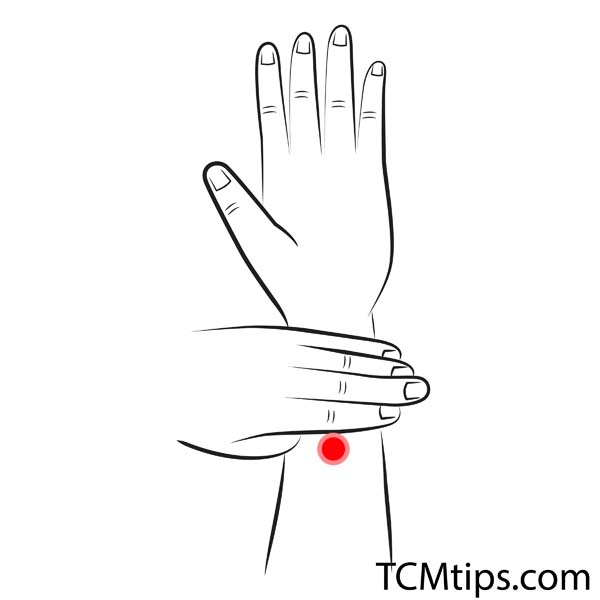
TE-6 is located on the dorsal side of the forearm, 3 cun above the transverse crease of the dorsum of the wrist, on the connecting TE-4, and the tip of the elbow between the radius and the ulna. It functions by removing obstruction from the three burners, opening the intestines by circulating qi in the intestines, clearing heat, and expelling wind. In addition to being useful as a tooth pain relief pressure point, it is also indicated as one of the acupressure points for constipation, as well as treating the pain of the lateral costal region and distention, clearing heat from the SJ channel, such as for febrile diseases, redness, pain and swelling of the eyes, tinnitus, and deafness, lockjaw, swollen jaw, and scrofula. It also resolves stagnation of qi in the chest, thereby providing relief to chest and heart pain.
You have to apply pressure on the opposite side of the toothache. For example, if your toothache occurs on the left side, you should press TE-6 on your right hand.

Acupoint: PC-6 (Other Names: Pericardium-6/Nei Guan/Inner Pass)
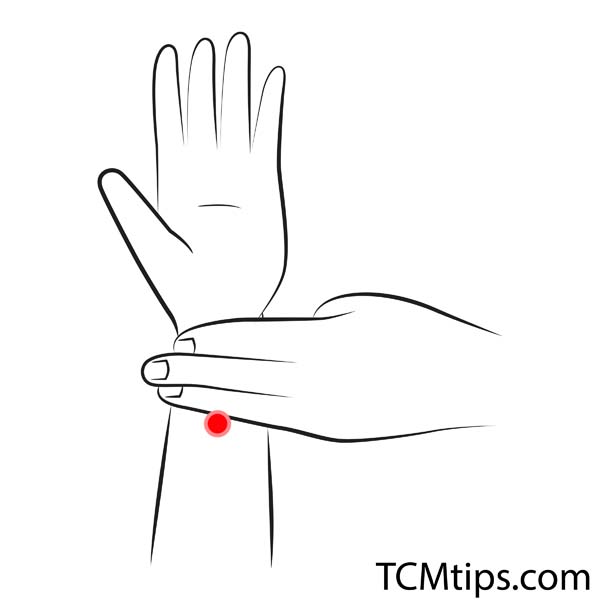
PC-6 is located on the palm side of the forearm, 2 cun above the transverse crease of the wrist, on the line connecting PC-3 and PC-7, between the tendons of the palmaris lonus and flexor carpi radialis muscles. It is classified as the Luo-Connecting point of the Pericardium meridian and master point of the Yin Wei vessel when coupled with SP-4. In addition to being a tooth pain relief pressure point, it is also one of the acupressure points for high blood pressure. It is also indicated for chest congestion, pain in the hypochondrium, cardiac pain, and palpitation, as well as epilepsy, hiccups, and vomiting. It’s also indicated for depression, dizziness, vertigo, apoplexy, hemiplegia, spasm and pain in the upper extremities, cough, asthma, irritability, and malaria. It functions by opening the chest, regulating heart qi, calming the shen, harmonizing the stomach, relieving nausea and vomiting, and regulating qi. Luo-Connecting points of one meridian can communicate with two other meridians. They treat diseases of the collaterals and chronic diseases, especially those of the Zang-Fu organs. It is often combined with Yuan-Source points.
Acupoint: ST-6 (Other Names: Stomach-6/Jia Che/Jaw Bone)
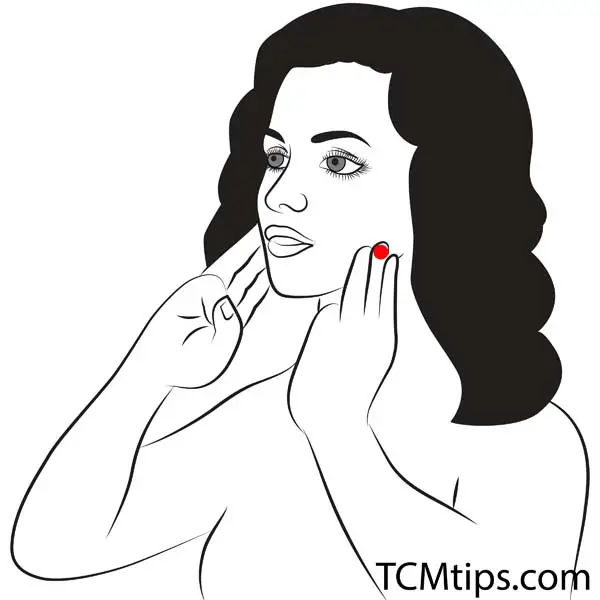
ST-6 is located on the cheek, in the depression one middle finger width anterior and superior to the lower angle of the mandible where the masseter muscle attaches when the teeth are clenched. It is indicated for swelling of the teeth, wry mouth or crooked jaw, toothache in the lower jaw, and acute trismus or difficulty in opening the mouth due to toothache. It is a great point for the treatment of TMJ. It functions by dispelling wind, clearing obstructions in the meridian, relieving pain, and benefiting the jaw and teeth. It is also one of the top 10 acupressure points to relieve body pains & ache.
Acupoint: ST-7 (Other Names: Stomach-7/Xia Guan/Below the Arch)
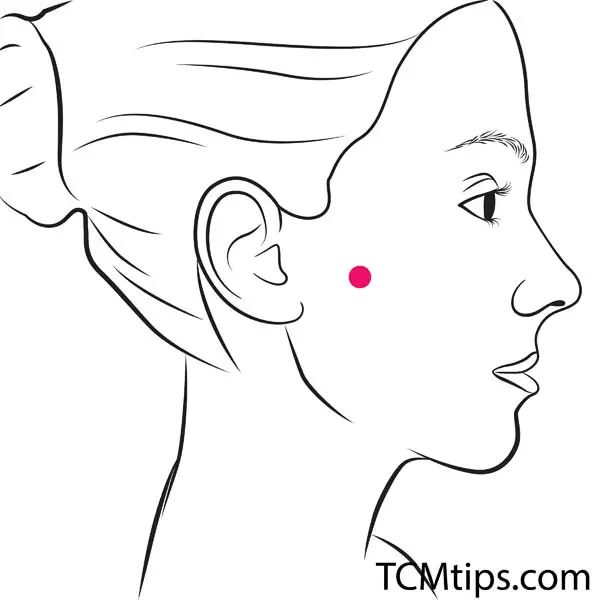
ST-7 is located on the face, anterior to the ear, in the depression between the zygomatic arch and the condyloid process of the mandible. It is classified as the crossing point of the stomach and gallbladder meridians. It is indicated as one of the acupressure points for a facelift, as well as for the treatment of deafness, tinnitus, toothache, nasal congestion, wry face, difficulty in opening the mouth, pain in the face, TMJ, and trigeminal neuralgia. It functions by clearing obstructions in the meridian, thereby benefitting the ears, jaw, and teeth.
How Can You Stop A Toothache Fast With Acupressure?

LI-4, or large intestine 4, is the acupuncture point for toothache that provides instant relief. It is used clinically for the treatment of stress, facial pain, headaches, toothaches, and neck pain. It is also commonly used as one of the acupressure points to quit smoking It is located on the highest spot of the muscle when the index finger and the thumb are brought together. In addition to being one of the most valuable acupressure points for tooth pain, it has been extensively studied in randomized controlled trials and clinical research. The Journal of Orofacial Pain showed stimulation of this pressure point for tooth pain reduced pain of the jaw muscles significantly. Additionally, it has shown stimulation of this acupoint is effective for the treatment of migraines and tension headaches.

How Should I Sleep With Tooth Pain?

Toothaches can intensify at night or when you’re sleeping due to built-up pressure from the blood rushing to your head. Sinuses can also increase tooth pain at night due to mucus getting trapped in your sinuses when you’re laying down. While less common, existing sinus problems can worsen tooth pain. In addition to using the acupressure points for toothache pain, you should sleep with your head elevated and avoid eating acidic, cold, or hard foods right before bed. You should also rinse your mouth with mouthwash and use an ice pack before bed.
Which Pressure Point Makes You Fall Asleep Instantly?
Acupoint: PC-6 (Other Names: Pericardium-6/Nei Guan/Inner Pass)

PC-6 is effective in the treatment of insomnia, which is a disturbance in sleep patterns as a result of difficulty falling asleep, staying asleep, or both. According to Traditional Chinese Medicine (TCM), heart and stomach dysfunctions could be related to sleep disturbances. Since this point is useful in regulating the normal functioning of the heart and stomach, it can be a useful acupressure point to aid in falling asleep. Studies are currently underway which are exploring how this and other acupressure points can be useful in improving sleep quality in older people. According to an article in Medical Acupuncture, PC-6 can be used to induce sedation.
 P. Sze
P. Sze 